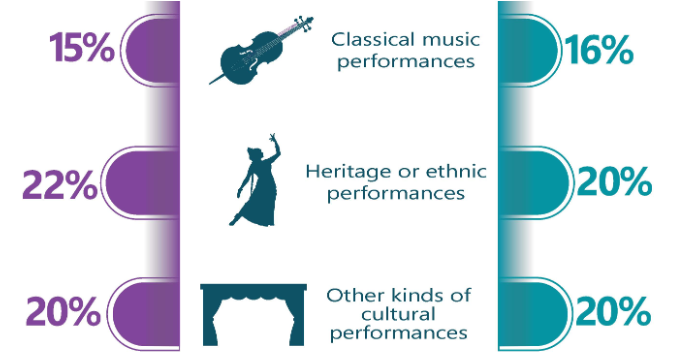March 10, 2020
Canadian youth are avid arts participants. That is a finding from the 2019 report, Demographic Patterns in Canadians’ Arts Participation in 2016.
While even those of us who work in the field may assume performing arts audiences to be primarily made up of older, largely white Canadians, evidence suggests otherwise.
As discussed in CAPACOA’s previous blog post, Kelly Hill’s presentation on Demographic Patterns in Canadians’ Performing Arts Participation highlighted the fact that audiences are less homogenous than we might assume. They are also younger.

Clearly, this broad demographic trend does not play out in every space. Walk into many performing arts spaces and it is easy to have your assumptions about audience age confirmed.
But arts attendance rates are in fact higher for youth (ages 15-24) than the Canadian average for most arts activities.
Young people are attending live arts performances of all kinds; not only movie theatres and pop concerts, but also music festivals, theatre, and arts galleries, all at higher rates than the national average. Even when movie theatres are excluded, overall arts attendance rates for youth are 9% higher than the national average.

For classical music, a genre we often associate with older audiences, the survey also found no significant difference in attendance rates between youth and older Canadians.
So if we are not seeing young people in our spaces, it is worth asking why. Those of us in the performing arts cannot afford to pretend that young people are simply not interested in live performance. They certainly are. So if they are still missing from our audiences, what can we do to bridge that gap?
What can we do to not simply market to younger audiences, but to make them feel welcome, included, and represented?
Kelly’s presentation also reminded us that content matters. For example, Indigenous, racialized, and immigrant Canadians have higher rates of attendance at what the report defined as “heritage or ethnic performances” than the national average. The same principle can be applied to youth, and it is worth considering the specific demographics and concerns of youth in your community.
For example, Arts and Heritage: Access and Availability, a survey of 2,045 Canadians conducted in 2016-2017, found that “reported attendance at performances by visible or ethno-cultural minorities is higher among younger Canadians under 35 (48% vs 38%).” As CAPACOA suggested in their analysis, this difference can be explained in part by the diverse makeup of the Millennial generation, and partially by a genuine interest in diverse performances.
As a young Canadian myself, I firmly believe that my demographic will show up for shows that matter to them.
They will show up if they feel listened to, if they see themselves reflected on stage, if they feel culturally and socially represented, if they care about the issue that a work is tackling, or if they see the potential for a fun and unique social experience.
Are we offering these experiences? And are we promoting them as such in our marketing materials? It is not enough to offer a discounted ticket price (though of course financial accessibility is also essential) if young people are not interested in the content.
Youth are also significantly more likely than older audiences to participate in artistic creation (64% as opposed to the 50% Canadian average).
Are we offering young people ways to not only see art, but to create it? Are we making them feel explicitly welcome in the space, and giving them the freedom to experience and create without fear of spoken or unspoken rules and codes of conduct?
Young people know what they want, and they know where they are wanted. They care about live arts experiences, it’s time our sector made clear that we care about them.
Check out CAPACOA’s recap post to access more insights, the full webinar, and further resources
This post was written by OP’s Communications and Membership Services Coordinator Natalie Dewan. Questions? Contact info@ontariopresents.ca
Graphics courtesy of Hill Strategies.

